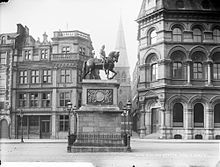College Green, Dublin
This article needs additional citations for verification. (April 2015) |
 | |
| Native name | Faiche an Choláiste Error {{native name checker}}: parameter value is malformed (help) |
|---|---|
| Namesake | Trinity College, Dublin |
| Length | 260 m (850 ft) |
| Width | 38 metres (125 ft) |
| Location | Dublin, Ireland |
| Postal code | D02 |
| Coordinates | 53°20′40″N 6°15′36″W / 53.34444°N 6.26000°W |
| west end | Dame Street |
| east end | Trinity College, Westmoreland Street, College Street |
| Other | |
| Known for | Trinity College, restaurants, nightclubs, statues, |

College Green (Irish: Faiche an Choláiste) is a three-sided plaza in the centre of Dublin, Ireland. On its northern side is the Bank of Ireland building, which until 1800 was Ireland's Parliament House. To its east stands Trinity College Dublin. To its south stands a series of 19th-century buildings that are mostly banks.
Streets leading onto College Green are Dame Street to the west, Grafton Street to the south, and Westmoreland Street to the north. College Green has been used as an assembly point for major political rallies. In the mid-1990s, United States President Bill Clinton addressed a crowd during his visit to Ireland. President Barack Obama spoke at the site in a major address during his visit in May 2011.[1]
History and layout
The area was once known as Hoggen Green from the Old Norse word haugr meaning mound, or barrow. The cemetery at College Green consisted of several burial mounds, which are thought to have contained the remains of some of the Norse kings of Dublin.[2] Between Church Lane and Suffolk Street the Norse had their Thing, an assembly and meeting-place, which was still to be seen in the 17th century. All along College Green, called Hoggen Green by the English, lay their barrows.[3] Hoggen gave its name to the convent of St Mary de Hogges, which stood roughly where the Bank of Ireland is now, and was a major landowner in the area until the Reformation.

Several public monuments stand in College Green, including a 19th-century statue of Henry Grattan, one of the leading members of the old Irish Parliament, which stands facing Trinity College. Another statue, standing further back, is of patriot Thomas Davis. Previously, this was the location of one of Dublin's finest equestrian statues, of King William III of England (William of Orange) on horseback, by Grinling Gibbons, which features in James Joyce's story The Dead. It was taken down after it was badly damaged in an explosion in November 1928.
Daly's Club, originally frequented by members of the old Irish Parliament, moved to number 3, College Green, in 1791 and remained there until it closed in the 1820s.[4]
College Green now exists as a street running from the front gates of Trinity College Dublin to pedestrian traffic lights close to The Central Bank in Dame Street at the junction of Trinity Street. The houses are numbered starting with 1 on the north side of the Street at Westmoreland Street and Trinity College and continuing across to the south side and back on the opposite side to Trinity College and the bottom of Grafton Street. Dubliners often incorrectly identify the street as Dame Street because it continues into Dame Street. College Street which runs from Pearse Street and Westmoreland Street passing railings on the Northern side of Trinity College Dublin is often thought to be College Green.
Traffic restriction

Since July 2009, College Green, during peak times on working days, has been accessible only to pedestrians, buses, taxis and cyclists.[5]
In 2016, plans were published for College Green to be fully pedestrianised, apart from a public-transport lane along the Trinity College side, to create a large public space in front of the Bank of Ireland. However, in October 2018 An Bord Pleanála, the state planning agency, rejected the plan.[6][7]
Proposed developments
There is ongoing debate about the future of College Green, with plans being led by the Green Party-led Dublin City Council to pedestrianise the plaza being piloted during 2019,[8][9] after planning permission for a permanently pedestrianised plaza was rejected by An Bord Pleanála in 2018.[10]
See also
- Statues in Dublin
- List of streets and squares in Dublin
- Dublin College Green (UK Parliament constituency)
References
- ^ Henry McDonald (23 May 2011). "Barack Obama cuts short Ireland visit after concerns over volcanic ash cloud". The Guardian. Retrieved 23 May 2011.
- ^ Hoggen Green ("Vikings in Dublin or Dyflin as they called it". Robert O'Connor. Viking Network)
- ^ Scandinavian Relations With Ireland During the Viking Period (A. Walsh, author. Dublin: The Talbot Press Limited. 1922)
- ^ T. H. S. Escott, Club Makers and Club Members (1913), pp. 329–333
- ^ "Change to College Green traffic restrictions". 18 November 2009. Retrieved 20 December 2016.
- ^ "College Green pedestrianisation plans to go before An Bord Pleanála". 4 October 2016. Retrieved 20 December 2016.
- ^ Olivia Kelly (18 October 2018). "College Green plaza plans are 'dead', council chief claims". Irish Times. Retrieved 18 October 2018.
- ^ "College Green traffic ban for three summer Sundays to test plaza plan". The Irish Times. June 23, 2019.
- ^ Lynott, Laura. "New trial to ban traffic on College Green for three days". Irish Independent.
- ^ Kilraine, John (17 October 2018). "Pedestrian plaza plans for Dublin's College Green refused". RTÉ.

